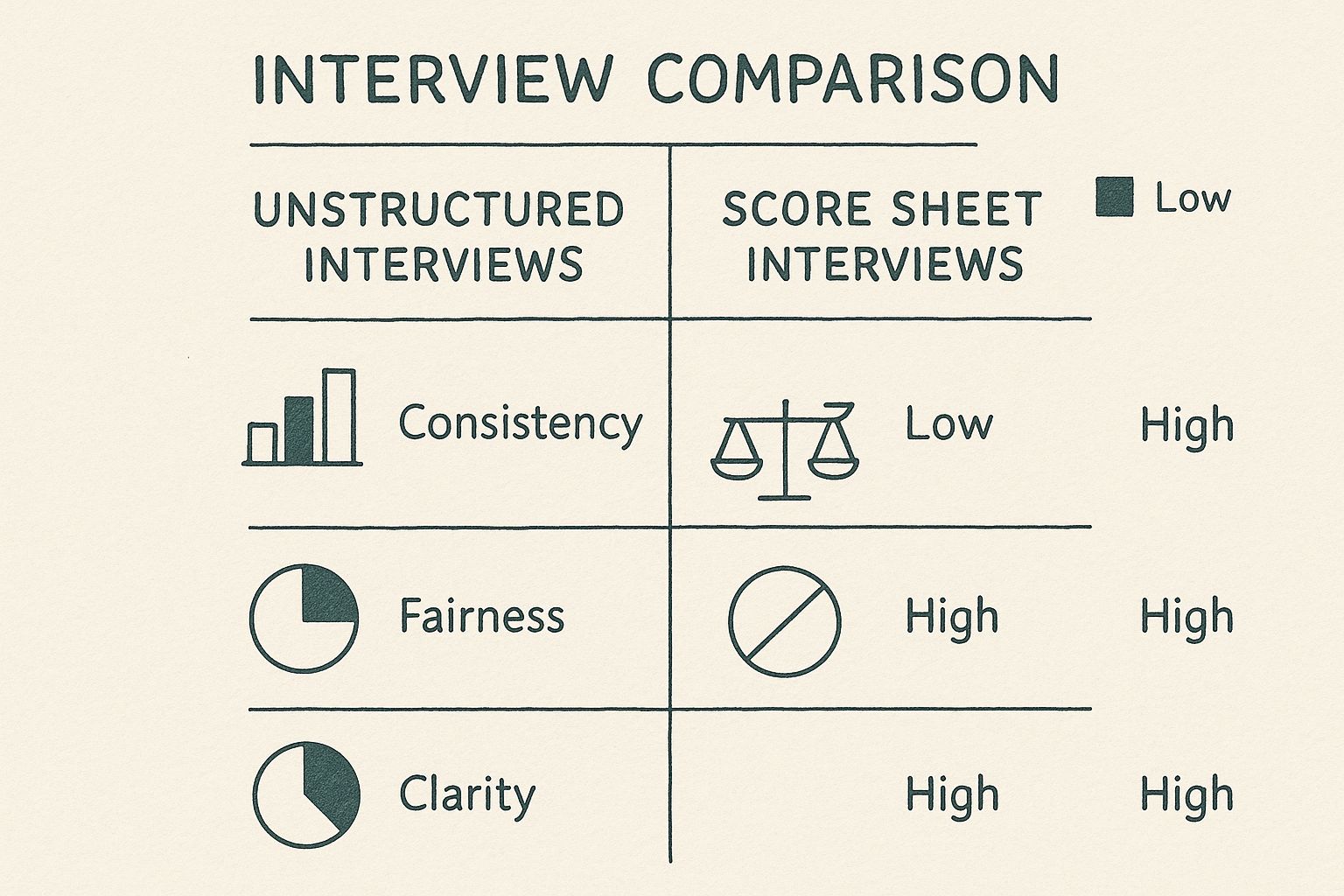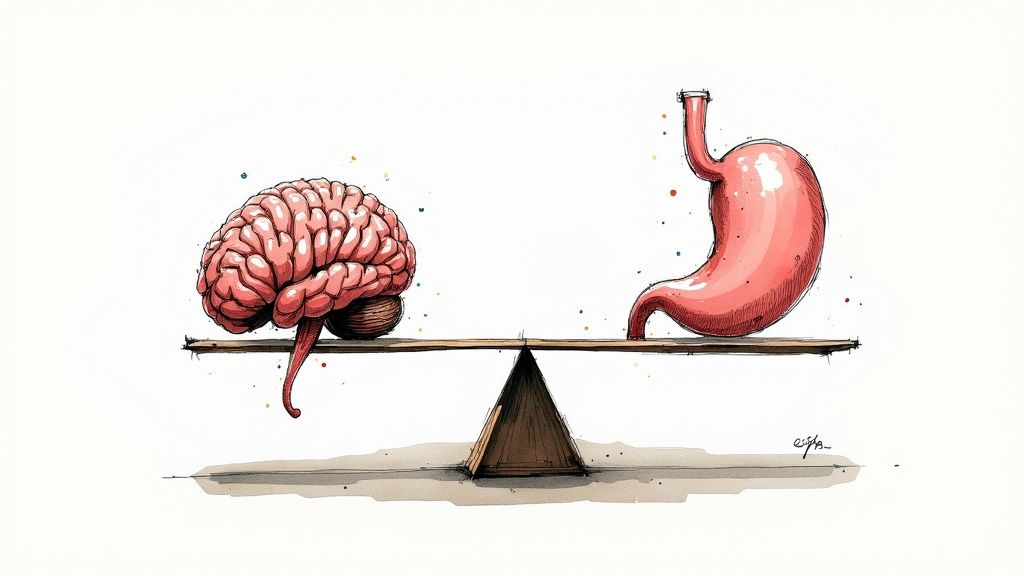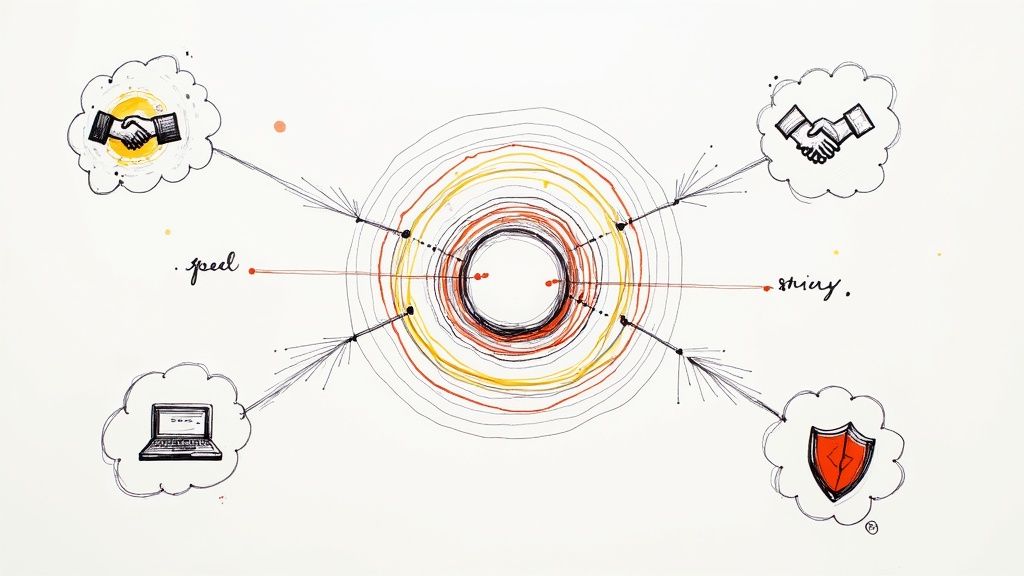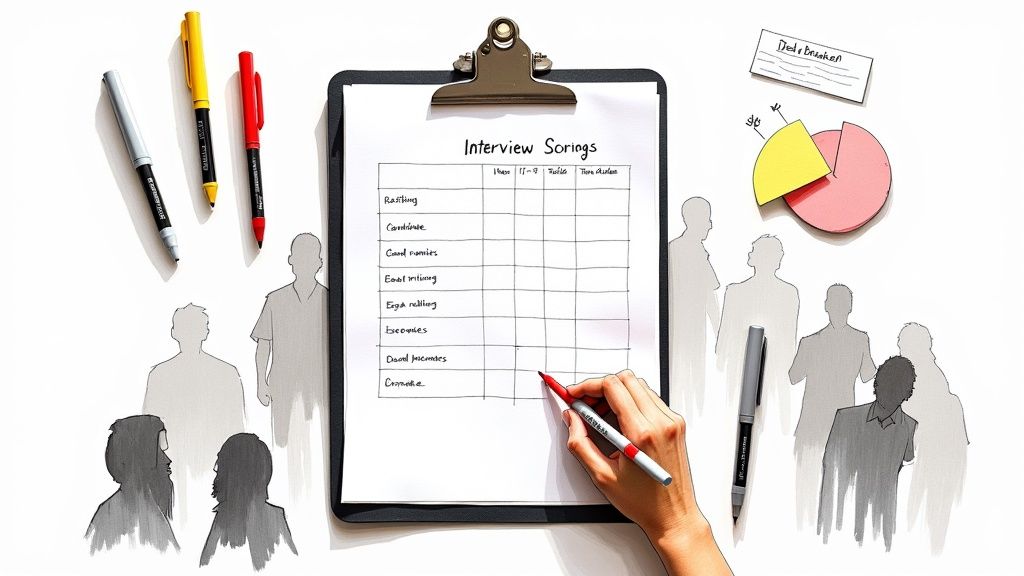An interview score sheet is a simple, structured tool used to evaluate candidates against the same set of criteria. The whole point is to swap out subjective "gut feelings" for objective, data-driven decisions, making sure every single applicant is measured with the same yardstick. It’s not more paperwork; it’s an insurance policy against your own biases.
The True Cost of a Bad Hire

Let’s be real for a second. We've all been there. You hire someone based on a "good feeling," only to realize a few months down the road that you've made a costly, soul-crushing mistake. It's almost a rite of passage for founders, but it's a painful one nobody wants to go through twice.
And the salary you paid them? That's just the tip of the iceberg. The real damage is a slow-burn disaster that poisons your entire operation from the inside out.
The Financial Black Hole
First, let's follow the money. A bad hire isn't just their salary—it's the recruitment fees, the onboarding costs, the training time, and the severance you eventually have to pay out. All in, you're looking at a financial blow that can easily top 30% of their first-year salary.
Suddenly, that $80k hire becomes a $104k blunder. This is the kind of mistake that forces you to delay a product launch or, worse, start thinking about mortgaging the office ping-pong table.
The Silent Killer of Productivity
The financial cost is painful, but it pales in comparison to the operational drag. A bad hire is a productivity sinkhole. They soak up more of your time with hand-holding, their mistakes create rework for everyone else, and their lack of output forces your star players to pick up the slack.
Before you know it, your A-team is spending half their day fixing someone else's mess instead of pushing the business forward. Projects stall, deadlines get blown, and all that forward momentum you built grinds to a halt.
You’re not just paying for one person’s underperformance; you’re paying for the lost output of everyone they touch. It's a tax on your entire team's potential.
The Morale Meltdown
This is the most insidious cost of all. Nothing sucks the energy out of a team faster than a colleague who isn’t pulling their weight. Resentment starts to build, communication breaks down, and your best people quietly start polishing their resumes.
Great employees want to work with other great employees. When they see you tolerating mediocrity, they start to question your leadership and the future of the company. You don't just lose one bad hire; you risk losing the very people you can't afford to lose.
Using robust hiring practices, like interview score sheets, is a core part of broader human capital risk detection strategies designed to stop these costly mistakes before they happen.
Don't think of them as more HR paperwork. Think of them as your single best insurance policy against hiring disasters. They force clarity, objectivity, and discipline into a process that’s too often left to chance. This guide will show you how to fix that—for good.
What Exactly Are Interview Score Sheets?
Alright, let's cut through the HR jargon. Forget what the textbooks say for a minute. At its heart, an interview score sheet is just a simple tool—a structured cheat sheet—for making smarter, less emotional hiring decisions. It’s not about adding more paperwork; it’s about adding consistency.
Think of it like this: you're a judge at a boxing match. Would you declare a winner based on who you liked more, or would you use a scorecard that tracks punches landed, knockdowns, and defensive moves? One method is a popularity contest; the other is a disciplined evaluation. Your hiring process deserves that same kind of rigor.
An interview score sheet forces you and your team to define what "good" actually looks like before the first candidate even walks through the door. It’s a pre-game huddle where you all agree on the rules, ensuring a level playing field for everyone. This simple act of preparation is often the difference between hiring someone who just interviews well and hiring someone who will actually perform well.
The Anatomy of a Good Score Sheet
So what goes into one of these things? It’s not rocket science, and you don’t need an expensive system to get started. A well-built score sheet is beautifully simple, boiling down to a few key parts that work together to paint a clear picture of a candidate's potential.
A good one feels immediately useful, not like you're studying for an exam. It’s a tool, not a test.
Here are the non-negotiable components:
- Key Competencies: These are the 3-5 skills or traits absolutely critical for success in the role. We're not talking about a laundry list from the job description; we’re talking about the handful of things that will make or break someone's performance. For a sales role, this might be "Objection Handling" or "Pipeline Management." For an engineer, it could be "System Design" or "Code Readability."
- A Simple Rating Scale: Don’t overcomplicate this. A 1-5 scale works just fine. The real key isn't the numbers themselves but the clear definitions behind them. What does a '3' look like versus a '5'? Define it upfront so your team's ratings aren't all over the map.
- A Dedicated Comments Section: This is where the magic happens. A rating is just a number, but the why behind it is everything. This space forces interviewers to provide specific evidence—actual quotes, examples, or observations—to back up their score. No more vague feedback like "seemed sharp."
This structured approach is what separates a truly effective hiring tool from just another piece of paper. You can explore a deeper dive into crafting the perfect evaluation framework by checking out our guide on creating a comprehensive interview score card.
It’s a Guardrail, Not a Straitjacket
Let’s bust a common myth right now. Using an interview score sheet doesn’t turn you into a hiring robot or remove the human element from the process. If anything, it does the exact opposite. By standardizing how you evaluate core skills, it frees up your mental energy to have a more meaningful, human conversation with the candidate.
A score sheet isn’t there to restrict your judgment; it’s a tool for clarity and fairness. It’s the guardrail that keeps your biases from driving the hiring decision into a ditch.
It protects you from the "halo effect," where you love a candidate's answer to one question so much that you ignore red flags later on. It also protects you from "affinity bias," where you subconsciously favor the person who went to the same college or shares your love for obscure 90s rock bands.
Ultimately, score sheets are about one thing: making better, more defensible decisions. They replace fuzzy gut feelings with structured evidence, giving you the confidence that you’re not just hiring the person you liked the most, but the person who is genuinely the best fit for the job. And in a startup, that distinction is everything.
How to Build a Score Sheet That Actually Works
Alright, you get it. Winging it is a terrible strategy, and score sheets are the answer. So, where do you start? Let’s roll up our sleeves and build one that isn't just another piece of HR fluff. This is the founder-to-founder blueprint, based on mistakes I’ve made so you don’t have to.
Building effective interview score sheets isn’t about creating a bureaucratic nightmare; it's about forcing clarity. It forces you to stop and ask the most important question before you ever speak to a candidate: "What does success in this role actually look like?"
The following infographic drives this point home, showing the stark difference between unstructured interviews and those guided by score sheets. You'll see a clear improvement in consistency, fairness, and overall clarity.

As you can see, a structured approach with score sheets dramatically improves the metrics that lead to better, more defensible hiring decisions. It’s not even a close contest.
Ditch the Laundry List for Non-Negotiables
First things first, your job description is not your score sheet. A job description is a marketing document designed to attract candidates; a score sheet is an evaluation tool designed to assess them. Don't just copy and paste the "responsibilities" section and call it a day.
Instead, sit down with your team and identify the 3-5 core competencies that are absolutely non-negotiable for the role. These are the make-or-break skills or traits. Anything more than five and you're just creating noise.
For example, when hiring a Senior Product Manager, your non-negotiables might be:
- Data-Driven Decision Making: Can they use metrics to defend a product roadmap decision?
- Stakeholder Communication: Can they get engineering, sales, and marketing all rowing in the same direction?
- Technical Literacy: Can they have a credible conversation with an engineer about trade-offs?
- User Empathy: Do they genuinely care about solving the user's problem, or just shipping features?
See the difference? We're not listing "5+ years of PM experience." We're defining the behaviors that make a great PM.
Keep Your Rating Scale Simple, Stupid
I’ve seen score sheets with complex 10-point scales and weighted averages that would make a statistician’s head spin. Don't do it. All you need is a simple 1-to-5 scale.
The secret isn’t the numbers themselves, but what they stand for. Before anyone on your team uses the score sheet, you must agree on what each number means.
A rating scale without clear definitions is just a prettier way to capture gut feelings. It’s useless.
Here’s a dead-simple framework you can steal:
- 1 – Major Red Flag: The candidate demonstrated a significant gap in this area.
- 2 – Some Gaps: The candidate struggled to provide evidence or showed weakness.
- 3 – Meets Expectations: Solid performance. They have the skills required.
- 4 – Exceeds Expectations: Provided strong, compelling evidence of their ability.
- 5 – Exceptional: Truly impressive. Among the best I’ve seen for this skill.
That's it. It’s clear, easy to use, and forces interviewers to take a stance. No more "soft yes" or "maybe" ratings.
Swap 'Culture Fit' for 'Culture Contribution'
This might be the most important change you make. The term "culture fit" is a trap. It's lazy shorthand that often becomes a breeding ground for affinity bias—we hire people who look, think, and act just like us. That’s how you build a monoculture, not a dynamic team.
Scrap that box entirely. Replace it with "Culture Contribution."
This subtle shift in language changes the entire question. Instead of asking, "Will they blend in?" you're asking, "What new perspective, skill, or experience will they bring to our team?" It celebrates what makes a candidate different, not what makes them the same. You're looking for someone who adds a new instrument to the orchestra, not another violin.
For a deeper dive into building out this kind of evaluation framework, you can learn more about crafting effective interview scoring sheets in our detailed guide.
To make this all painfully clear, let's compare a weak score sheet to a strong one. It's easy to see how one leads to gut-feel hires and the other leads to predictable success.
Good Score Sheet vs Bad Score Sheet
| The Bad (Vague and Useless) | The Good (Specific and Actionable) |
|---|---|
| Criteria: "Good Communicator" This means nothing. Is that written? Verbal? To who? |
Criteria: "Technical Communication" Defined as: "Ability to explain complex technical concepts to non-technical stakeholders (e.g., sales, marketing)." |
| Rating Scale: 1-5 (No definitions) One person's '4' is another's '2'. |
Rating Scale: 1-5 (With clear benchmarks) '5 – Exceptional' means they used analogies and checked for understanding without prompting. |
| Culture Section: "Culture Fit?" (Yes/No) A checkbox for unconscious bias. |
Culture Section: "Culture Contribution" Prompt: "What unique perspective or skill would this candidate add to our current team?" |
A great score sheet isn't complicated. It's just intentional. It's a blueprint for a better conversation and, ultimately, a better hire.
Why Your Gut Feeling Is a Terrible Hiring Tool

Let's get real for a minute. I can already hear the pushback: “This structured approach is nice, but I’ve got a knack for this stuff. I have great instincts. I can just tell when someone’s a winner.”
And I get it. As leaders and founders, we practically live and die by our gut feelings. We trust them to guide big product decisions, navigate tricky funding rounds, and close major deals. So why shouldn’t we trust them to pick people?
Because, frankly, our brains are lying to us.
When it comes to hiring, your gut is a terrible, biased, and wildly inconsistent tool. It’s not a finely-tuned instrument; it’s a jumble of cognitive shortcuts that evolution hardwired into our skulls to make snap judgments about who’s a friend and who’s a foe. That was super helpful for surviving on the savanna, but it’s a lot less useful for hiring a Senior Backend Engineer.
Meet Your Brain's Biased Co-Pilots
These shortcuts are known as unconscious biases, and even the most well-intentioned leaders are completely susceptible to them. They run silently in the background, nudging our decisions in ways we don’t even notice. Think of this as a friendly intervention—it’s not about shame, but about acknowledging we’re all human.
Here are a couple of the most notorious offenders that love to crash an interview:
- The Halo Effect: This happens when a candidate says one brilliant thing early on, and you spend the rest of the interview seeing everything else they say through a golden haze. They absolutely nailed your favorite technical question? Suddenly, their vague answers on team collaboration don’t seem so bad. You’ve crowned them with a halo, and it's blinding you to some very real red flags.
- Affinity Bias: This one is even more dangerous. It’s that powerful, subconscious pull we feel toward people who remind us of… well, ourselves. Maybe they went to the same university, grew up in the same state, or share your love for rock climbing. You instantly feel a connection, and that warmth gets misinterpreted as "a great culture fit." It's the fast track to building a team of clones who all think alike.
Relying on your gut isn’t a sign of sharp intuition; it’s an open invitation for bias to take the driver’s seat. It feels good in the moment but almost always leads to a crash.
The real danger here is that these biases feel like smart, intuitive judgments. We don’t realize we’re favoring one candidate for reasons that have absolutely nothing to do with their ability to excel at the job. If you want to go deeper on how these mental shortcuts can sabotage your hiring, check out our piece on unconscious bias in recruitment.
Your Best Defense Is a Good Score Sheet
So, how do we fight back against our own flawed brains? We install some guardrails. An interview score sheet is that guardrail. It's not about taking the humanity out of the process; it’s about systematically rooting out the unfairness.
A score sheet forces you to define what “good” actually looks like before bias has a chance to creep in. When you have to rate every single candidate on "Stakeholder Communication" using a pre-defined 1-5 scale, it’s a lot harder to let the person you "just clicked with" slide by with a weak answer.
By setting up clear evaluation criteria tied to the core competencies for the role, you make sure that candidates are assessed fairly and consistently, no matter who is interviewing them. This approach is a huge boost for any Diversity, Equity, Inclusion, and Belonging (DEIB) initiative, but it also just plain improves your decision-making with structured feedback and hard numbers.
Ultimately, using interview score sheets turns a subjective chat into a structured, data-gathering exercise. It ensures that when you sit down to make that final, critical decision, you’re comparing apples to apples—not one great answer to a charming personality.
Surprising Benefits Beyond a Better Hire

So, we agree: using an interview score sheet helps you pick the winner more consistently. Great. But if you think that’s where the benefits end, you're missing half the story. The real power of this simple tool isn’t just in making a better hire—it’s in how it completely transforms your entire hiring operation.
Adopting score sheets creates ripple effects you probably didn't see coming. It’s not just a tweak to your process; it’s a fundamental upgrade that pays dividends long after the offer letter is signed. And frankly, some of these "side effects" are just as valuable as the main event.
Killing the Endless Debrief Meeting
You know the meeting I’m talking about. The one where five people who interviewed the same candidate sit in a room for an hour, vaguely trying to remember what was said and asking, "So… what did everyone think?" It’s a rambling, subjective, and soul-crushing waste of time.
Score sheets kill this meeting. Dead.
Instead of fuzzy recollections, your debrief is now a focused, evidence-based discussion. You’re not debating feelings; you’re comparing data points. The conversation shifts from "I got a good vibe from them" to "They scored a '2' on stakeholder communication, and here’s the specific example why."
Suddenly, your decision-making process is 5x faster because you’re arguing about evidence, not opinions. You get back hours of your team's most expensive time.
The Candidate Experience Power-Up
Candidates can tell when they’re in a sloppy, unstructured interview process. They feel it. It comes across as unprofessional and, frankly, a bit disrespectful of their time.
A structured process guided by a score sheet does the opposite. It signals that you are organized, fair, and serious about finding the right person. This perception dramatically improves the candidate experience. When applicants feel they were given a fair shot and evaluated on their merits, they walk away with a positive impression, even if they don’t get the offer.
This has a tangible impact on your bottom line. Research shows that using scorecards can improve the offer acceptance rate because candidates feel the process was transparent and professional.
The "Cover Your Backside" Benefit
Now for the pragmatic, less glamorous, but incredibly important part. In today's world, hiring decisions can be challenged. A disgruntled candidate can claim discrimination or unfair treatment, and if your process was based on "gut feelings," you have a serious problem.
An interview score sheet is your best defense.
It provides a documented, consistent record of why you made the decision you did, for every single candidate. It shows that you evaluated everyone against the same objective, job-related criteria. This is invaluable evidence of a fair process, which is essential for compliance and mitigating legal risks.
It’s the boring, cover-your-backside benefit every founder needs to take seriously. A great hire today can impact your business for years, so it's critical to understand the long-term view. Grasping the distinction between employee training vs development is key to maximizing the value of the talent you bring on board. In short, a score sheet isn’t just about hiring well; it’s about hiring safely.
Putting Score Sheets Into Action
Alright, we’ve covered the why and the what. Now for the how—without the headache. This is where the theory hits the road, giving you a real-world, no-excuses plan to make this system stick, starting with your very next hire.
Let's bust a myth right now. The biggest lie in hiring is that you need some complicated, expensive applicant tracking system to be disciplined. You don’t. A well-designed spreadsheet is a thousand times better than just winging it based on who you vibed with over coffee. The goal here is progress, not perfection.
Your Simple Action Plan
Don’t try to boil the ocean. You're not going to overhaul your entire company’s hiring process by Tuesday. Instead, just focus on a single, high-stakes role and commit to doing it right, just this once.
Here’s your checklist. It’s painfully simple on purpose.
- Pick One Critical Hire: Choose the next role that really matters. Is it your first sales lead? A senior engineer? Pick one where a mistake would genuinely hurt.
- Build a "Good Enough" Score Sheet: Steal the template from the previous section. Spend 30 minutes with your team defining the 3-5 absolute non-negotiables. Don't overthink it.
- Get Your Team On Board (The Right Way): This is the crucial part. Don't just email them a spreadsheet and say, "use this." Explain the why. Tell them this isn't about more paperwork; it's about making their own jobs easier by hiring better colleagues and short-circuiting our natural biases. Frame it as a tool for them, not a rule from you.
This isn't about becoming a hiring machine overnight. It's about making one single hiring decision with more clarity and less bias than you did last time. That's the win.
This focused approach creates a small, tangible victory you can build on. Once your team sees how a structured process leads to a faster, more confident decision, they’ll start asking for it for every role. (Toot, toot! That’s the sound of your own horn you’ll be hearing.)
Ultimately, it’s about making your interview process more efficient. Data shows the interview-to-hire ratio is roughly 27%; those who make it to the interview have a strong chance if the process is sharp. An interview score sheet is your efficiency engine, ensuring you quickly and accurately spot the best candidate in that qualified pool. You can explore more job interview statistics to see how efficiency shapes outcomes.
So stop just talking about fixing your hiring process and just start. Start small, start messy, but start now.
Frequently Asked Questions
Alright, let's tackle the questions I hear most often. When I first moved away from just trusting my gut on hires, I had these same thoughts buzzing around. Here are the straight answers to the most common concerns.
How Much Time Does This Really Take?
I’ll be direct: it takes way less time than cleaning up the mess from a bad hire. Honestly.
Your very first score sheet, built from scratch with your team, might take about an hour. But once you have that template? You can tweak it for a new role in 15 minutes, tops. Think of it as a small investment upfront to save yourself from dozens of hours of painful performance management and endless "what went wrong" meetings later. It's a trade-off I'm happy to make every single time.
What if Interviewers Still Score Differently?
They will. That's actually part of the process, not a problem with it. One person's "4" is bound to be another person's "3," especially when you're just starting out.
This is exactly why the comments section is non-negotiable. A number without context is just an opinion.
When you see a big gap in scores—say, a "2" right next to a "4"—it's a signal to dig in during your debrief meeting. The first question should always be, "Okay, what specific evidence did you see that I might have missed?"
This simple question forces the conversation to shift from vague feelings to observable behaviors. It's how your team gets on the same page and sharpens its hiring instincts over time. That's the whole point of using interview score sheets in the first place.
Should We Share the Score Sheet with Candidates?
Definitely not. The score sheet is an internal tool, your team's playbook for making a fair, consistent decision. Sharing it would be like a poker player showing their hand to everyone at the table.
It would encourage candidates to perform for a test instead of just being themselves, which completely defeats the purpose. You want to see how they actually think and solve problems, not how well they can memorize your checklist. Keep it internal—always.
Ready to stop gambling on gut feelings and start building a more predictable hiring process? Async Interview embeds a structured, scorecard-based evaluation right into your workflow. No more messy spreadsheets or trying to remember who said what—just clear, consistent, and collaborative hiring. See how you can build a better team, faster.




